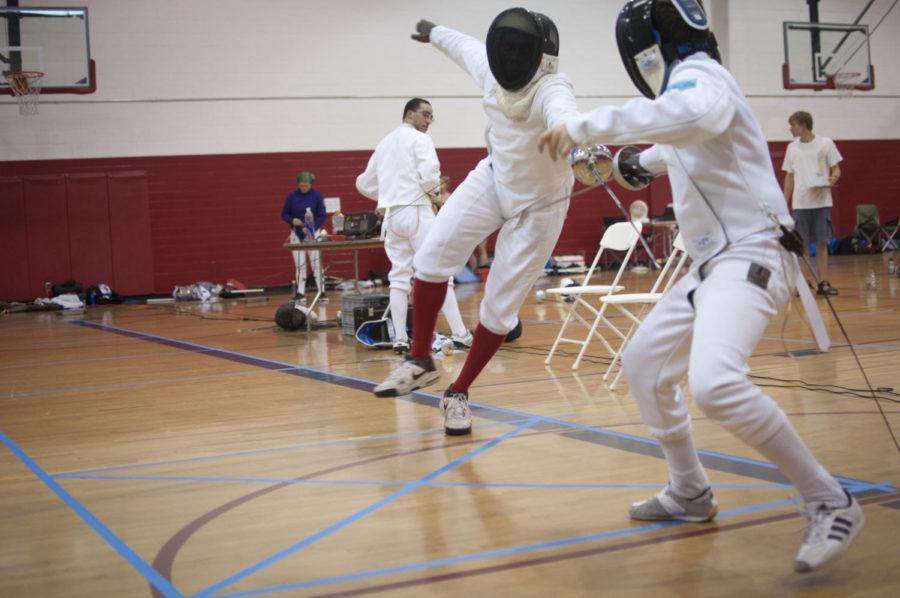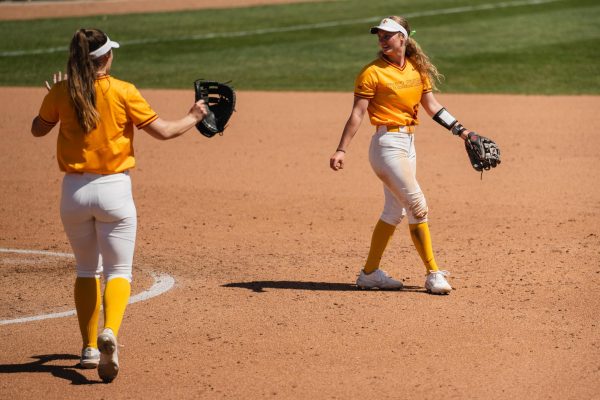ISU fencers compete in 2011 Iowa Games
Rene Hamilton, right, senior in aerospace engineering, attempts to score a point while his opponent blocks him during the Iowa Games fencing competition on July 16 in Beyer Hall.
July 17, 2011
Many people compare fencing to the game of chess. Both games involve striking an opponent, as well as positioning oneself to make offensive and defensive moves.
But in fencing, unlike chess, decisions must be made immediately.
“It moves at 300 miles an hour,” said Steven Behrends, fencing master at the Des Moines Fencing Club. “You make the move, but you have to do it in split-second decisions.”
A number of clubs, including Behrends’, came together at the fencing tournament for the 2011 Iowa Games on Saturday. It was a daylong event that featured three different versions of fencing: foil, epee and saber.
Yuly Suvorov from the ISU Fencing Club won the epee event. David Bell and Jesse Rothfus from the Des Moines Fencing Club won the events for the foil and saber club, respectively.
Foil and epee focus on hitting the opponent with the tip of one’s weapon. In foil, one has to hit an opponent in the upper body, where the most damage can be inflicted. Hitting the arms and legs does not count.
In epee, the opponent’s entire body is a target. Saber competitors use a sword, attempting quick, slashing strikes at their opponents. This is the fastest version of fencing.
Behrends, who was also fencing commissioner at the Iowa Games, explained why he has been coaching fencing for the last 14 years.
“I was not into athletics at all.” Behrends said. “In high school, I was very small. But I found out in fencing it did not matter. Size does not matter. It is physically demanding, but it is mentally demanding as well.”
The ISU Fencing Club had some other members who participated in the event, including Rene Hamilton and Eric Windsor.
Hamilton, who is a senior at Iowa State, has been fencing for more than two years and participated in all three events.
Most fencers at the event said they liked one form of fencing, but excelled in another form.
“Foil is the one I enjoy the most, but as for the one I am best at, [it] is a different question entirely,” Hamilton said. “I do not like epee. I like the methodical way of foil. Everything in epee is a target, and I am just not comfortable with that.”
Hamilton earned a sixth place finish in foil. He took eighth place in both epee and saber.
Windsor, who coaches the fencing club, participated in just foil and epee. He finished in fifth place in both events.
“I fence foil in tournaments.” Windsor said. “I fence epee just for the fun of it.”
Unlike Hamilton, Windsor has been fencing since the age of 12. He’s been in the fencing club since his freshman year at Iowa State.
“Initially, my older sisters were fencing.” Windsor said. “As soon as I got to college, I tried the fencing club.”
The fencing tournament continues to grow, and local tournaments like this one show how much the sport is growing in the Midwest. Iowa hosted the North American Cup in 2008.
“It’s been growing up steadily since my first year on the scene as coach,” Behrends said. “As more people understand the sport, I hope it continues to grow.”

















